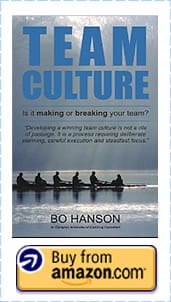What’s critical in driving sport team culture?
Culture is a buzz word in sport. Coaches often attribute their success or failure on this ambiguous word. Every team has a culture and even if you do not know what yours is, one exists. The real question is, what impact is it having on your team right now?
Culture is ‘how things are done around here’ – the consistent behaviors the team lives by on a daily basis. Ultimately, culture will make or break your team.
Characteristics of a high-performance Sport Team Culture
Regardless of the sport, there are certain characteristics of high-performance cultures:
- Alignment to a clearly defined team goal or purpose
- Strong adherence to living team values on a daily basis
- Team values almost always include trust and honesty
- Ingrained personal accountability for performance
- Individuals know how to contribute their best for the team, both from a technical perspective (i.e. their position or physical input) and non-technical (i.e. how to add value to others)
- Relationships within the team are highly valued and consistently invested in
- The team has high standards and quality processes
- Communication is strong, feedback is given and received daily
- Everyone genuinely cares about each other, the team and performance
It is critical for coaches to understand what drives cultural behaviors, how to evaluate their own culture and then how to guide it to be what the team needs. Developing a high-performance culture need not be an overwhelming initiative. Within every culture, there are three distinct categories defining it: Systems, Symbols and Behaviors. Get these right and it’s on track.
Systems are the training methodology and programming. It includes performance management, the methods and timing of feedback, processes to help team members understand themselves and each other, how conflict is addressed, leadership models used, and systems to drive accountability, values and team identity.
Symbols are the concrete expression of the team’s culture. They include posters of quotes to tangibly represent team goals, values and identity; t-shirts as a reminder of what is most important; and artifacts representing significant team achievements.
Behavior is what team members do, the actions rewarded or punished within the team. It is what happens in practice and competition. Evaluate behavior as either contributing to a positive or poor result and address these behaviors accordingly.
So when reviewing your team culture, use this S-S-B model and evaluate how your culture can be improved. Read on for more articles and videos on Team Culture
Sport Team Culture eBook:
Is Team Culture making or breaking your team?
 “Developing a winning culture is not a rite of passage. It is a process requiring deliberate planning, careful execution and steadfast focus.”
“Developing a winning culture is not a rite of passage. It is a process requiring deliberate planning, careful execution and steadfast focus.”
Bringing together a group of people to forge a high performing team culture is no simple exercise. It doesn’t happen by itself, nor is it a ‘matter of time’. Master coaches understand the intricacies, focus and persistence it takes. Be confident in managing your team’s unique culture, with practical coaching strategies to keep your team on the right track. It can be difficult to find a resource that can effectively guide your team through the potential pitfalls of culture. But this eBook is designed to take you step by step through the four distinct types of culture, and how to coach for these cultures.
This article was featured in our latest People+Sport Magazine: Team Success Edition which is available to read online and in PDF here.
At Athlete Assessments, we’re here to provide you with excellence in service and to help you be your best. If there is anything we can assist you with, please Contact Us.





